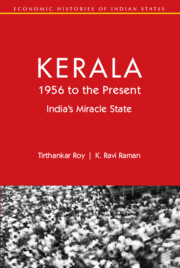Book contents
1 - Introduction
Published online by Cambridge University Press: 31 May 2024
Summary
The Miracle
In 1981, the south Indian state of Kerala was among the poorest regions in India. The state's average income was about a third smaller than the national average. In the late 1970s, by average income, Kerala was in the bottom third of India's thirty-odd states. In 2022, per capita income in the state was 50–60 per cent higher than the national average. Among those states large in land size, populous and with a diversified economic base, the state was the fifth richest in terms of average income in 2022. Gujarat, Karnataka, Tamil Nadu and Telangana were the other four. None of the others saw such a sharp change in relative ranking.
Kerala's economy did not grow steadily throughout these forty years. The acceleration, catching up and overtaking were not more than fifteen years old, twenty at the most. Income growth rates were low for much of the 1980s and the 1990s. The numbers changed sharply only in recent decades. The roots of this extraordinary growth performance, however, were much older. This book is a search for these roots.
It is not a common practice among economists to treat a state in India as the subject of long-term economic history. But ‘Kerala is different’ from all other Indian states. A huge scholarship building from the 1970s and drawing in many social scientists insisted it was different. Although poor, the population of the state lived much longer than the average Indian and had a significantly higher literacy rate than in the rest of India. The scholarship trying to explain this anomaly was mindful of history. But the history had a narrow purpose. It was made to work for a specific question: how did an income-poor region make great strides in human development? The discourse that emerged to answer the question had two critical weaknesses. First, it was too state-focused and neglected to analyse enough market-led changes. Second, it took income poverty for granted. Neither the question nor the answers offered are useful to explain the recent acceleration in income. The explanations could not show how the basic premise of a low income might change someday because the research agenda did not consider that prospect very likely.
- Type
- Chapter
- Information
- Kerala, 1956 to the PresentIndia's Miracle State, pp. 1 - 15Publisher: Cambridge University PressPrint publication year: 2024

